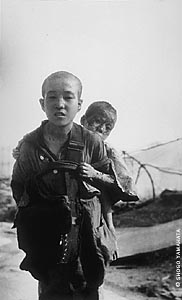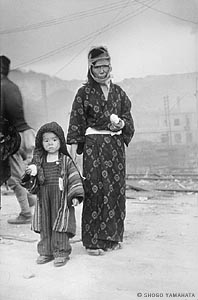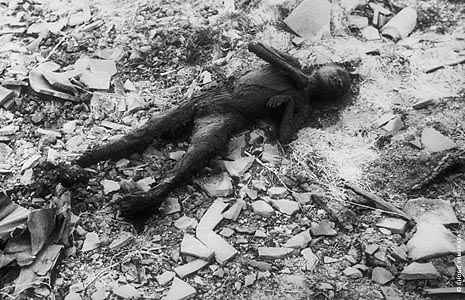
Photo by Yosuke Yamahata
Boy carrying small
burned child
Nagasaki, August 1945
|
From
A People’s History of the United States
by Howard Zinn,
and the
Political Literacy Course
of the Common Courage Press:
The
bombing of Japanese cities continued the strategy of saturation bombing to destroy civilian morale; one nighttime fire-bombing of Tokyo took 80,000 lives. (Zinn points out in the book that “nighttime bombing” was by its very nature indiscriminate, not aimed primarily at military targets.)
And then, on August 6, 1945, came the lone American plane in the sky over Hiroshima, dropping the first atomic bomb, leaving perhaps 100,000 Japanese dead, and tens of thousands more slowly dying from radiation poisoning.
Twelve U.S. navy fliers in the Hiroshima city jail were killed in the bombing, a fact that the U.S. government has never officially acknowledged, according to historian Martin Sherwin (“A World Destroyed”).
Three days later, a second atomic bomb was dropped on the city of Nagasaki, with perhaps 50,000 killed.
The justification for these atrocities was that this would end the war quickly, making unnecessary an invasion of Japan. Such an invasion would cost a huge number of lives, the government said — a million, according to Secretary of State Byrnes; half a million, Truman claimed was the figure given by General George Marshall. (When the papers of the Manhattan Project — the project to build the atom bomb — were released years later, they showed that Marshall urged a warning to the Japanese about the bomb, so people could be removed and only military targets hit.)
These estimates of invasion losses were not realistic, and seem to have been pulled out of the air to justify bombings which, as their effects became known, horrified more and more people.
Japan, by August 1945, was in desperate shape and ready to surrender. A New York Times military analyst wrote, shortly after the war:
“The enemy, in a military sense, was in a hopeless strategic position by the time the Potsdam demand for unconditional surrender was made on July 26.”
Such then, was the situation when we wiped out Hiroshima and Nagasaki.
The United States Strategic Bombing Survey, set up by the War Department in 1944 to study the results of aerial attacks in the war, interviewed hundreds of Japanese civilian and military leaders after Japan surrendered, and reported just after the war:
“Based on a detailed investigation of all the facts and supported by the testimony of the surviving Japanese leaders involved, it is the Survey’s opinion that certainly prior to December 31 1945, and in all probability prior to 1 November 1945, Japan would have surrendered even if the atomic bombs had not been dropped, even if Russia had not entered the war, and even if no invasion had been planned or contemplated.”
But could American leaders have known this in August 1945?
The answer is, clearly, yes. The Japanese code had been broken, and Japan’s messages were being intercepted.
It was known the Japanese had instructed their ambassador in Moscow to work on peace negotiations with the Allies. Japanese leaders had begun talking of surrender a year before this, and the Emperor himself had begun to suggest, in June 1945, that alternatives to fighting to the end be considered.
On July 13, Foreign Minister Shigenori Togo wired his ambassador in Moscow: “Unconditional surrender is the only obstacle to peace.” Martin Sherwin, after an exhaustive study of the relevant historical documents, concludes: “Having broken the Japanese code before the war, American Intelligence was able to — and did — relay this message to the President, but it had no effect whatever on efforts to bring the war to conclusion.”
If only Americans had not insisted on unconditional surrender — that is, if they were willing to accept one condition to the surrender, that the Emperor, a holy figure to the Japanese, remain in place — the Japanese would have agreed to stop the war.
Why did the United States not take that small step to save both American and Japanese lives? Was it because too much money and effort had been invested in the atomic bomb not to drop it? General Leslie Groves, head of the Manhattan Project, described Truman as a man on a toboggan, the momentum too great to stop it.
Or was it, as British scientist P.M.S. Blackett suggested (“Fear, War, and the Bomb”), that the United States was anxious to drop the bomb before the Russians entered the war against Japan?
The Russians had secretly agreed (they were officially not at war with Japan) they would come into the war ninety days after the end of the European war. That turned out to be May 8, and so, on August 8, the Russians were due to declare war on Japan.
But by then the big bomb had been dropped, and the next day a second one would be dropped on Nagasaki; the Japanese would surrender to the United States, not the Russians, and the United States would be the occupier of postwar Japan.
In other words, Blackett says, the dropping of the bomb was “the first major operation of the cold diplomatic war with Russia.”
Blackett is supported by American historian Gar Alperovitz (“Atomic Diplomacy”), who notes a diary entry for July 28, 1945, by Secretary of the Navy James Forrestal, describing Secretary of State James F. Byrnes as
“most anxious to get the Japanese affair over with before the Russians got in.”
Truman had said, “The world will note that the first atomic bomb was dropped on Hiroshima, a military base. That was because we wished in this first attack to avoid, insofar was possible, the killing of civilians.”
It was a preposterous statement. Those 100,000 killed in Hiroshima were almost all civilians. The U.S. Strategic Bombing Survey said in its official report:
“Hiroshima and Nagasaki were chosen as targets because of their concentration of activities and population.”
The dropping of the second bomb on Nagasaki seems to have been scheduled in advance, and no one has ever been able to explain why it was dropped. Was it because this was a plutonium bomb whereas the Hiroshima bomb was a uranium bomb? Were the dead and irradiated of Nagasaki victims of a scientific experiment?
Martin Sherwin says that among the Nagasaki dead were probably American prisoners of war. He notes a message of July 31 from Headquarters, U.S. Strategic Air Forces, Guam, to the War Department:
“Reports prisoner of war sources, not verified by photos, given location of Allied prisoner of war camp one mile north of center of city of Nagasaki. Does this influence the choice of this target for initial Centerboard operation? Request immediate reply.”
The reply: “Targets previously assigned for Centerboard remain unchanged.”
True, the war ended quickly. Italy had been defeated a year earlier. Germany had recently surrendered, crushed primarily by the armies of the Soviet Union on the Eastern Front, aided by the Allied armies on the West. Now Japan surrendered. The Fascist powers were destroyed.
But what about fascism — as idea, as reality? Were its essential elements — militarism, racism, imperialism — now gone? Or were they absorbed into the already poisoned bones of the victors.

“The world has achieved brilliance without conscience. Ours is a world of nuclear giants and ethical infants.”
— General Omar Bradley
Second-Guessing Hiroshima

Photo by Yosuke Yamahata
Mother and child
Nagasaki, August 1945
|
By Leo Maley III and Uday Mohan
Second-guessing
the necessity and morality of the atomic bombing of Hiroshima and Nagasaki 55 years ago is nothing new. Contrary to widely held opinion, the first critics of America’s use of atomic weapons were not disillusioned 1960s radicals but figures from the conservative establishment and the highest ranks of the military.
Criticism began within days of the obliteration of the two Japanese cities. On August 8, 1945, two days after the destruction of Hiroshima, former President Herbert Hoover wrote,
“The use of the atomic bomb, with its indiscriminate killing of women and children, revolts my soul.”
Two days later, John Foster Dulles and Methodist Bishop G. Bromley Oxnam together urged President Truman to forgo additional use of the new weapon, saying they opposed the bomb’s indiscriminate obliteration of human beings.
Within days of the Hiroshima bombing, David Lawrence, the editor of what is now “U.S. News & World Report,” wrote that Japanese surrender had appeared inevitable weeks before the bomb’s use.
The claim of “military necessity,” he argued, rang hollow. Official justifications would “never erase from our minds the simple truth that we, of all civilized nations ... did not hesitate to employ the most destructive weapon of all times indiscriminately against men, women and children.”
Such criticisms were not limited to civilians. The very day after the atomic bomb hit Hiroshima, the personal pilot of General Douglas MacArthur, commander of Allied forces in the Pacific, recorded in his diary that MacArthur was “appalled and depressed by this Frankenstein monster.”
In 1963 President Eisenhower, the Allied commander in Europe during World War II, recalled, as he did on several other occasions, that in July 1945 he had opposed using the atomic bomb on Japan during a meeting with Secretary of War Henry Stimson:
“... I told him I was against it on two counts. First, the Japanese were ready to surrender and it wasn’t necessary to hit them with that awful thing. Second, I hated to see our country be the first to use such a weapon.”
No one should easily discount these views. These six men were all respected public figures. With the exception of Oxnam, all were conservatives. None was a pacifist. None of the five who survived into the 1960s publicly opposed the war in Vietnam.
Their dissenting opinions were not based on hindsight. They voiced their beliefs even before the war ended. These men considered the use of the atomic bomb to have been militarily unnecessary and morally repugnant based on the information available to them in the summer of 1945.
Keep this in mind when, on Hiroshima anniversaries, you hear claims that opposition to the bombing emerged only in the 1960s, or that critics must, necessarily, be liberals or pacifists.
The comments of men such as Hoover and Eisenhower, leading Republicans whose qualities of caution and prudence cannot be questioned, lend support to the view that America’s use of atomic weapons to end World War II cannot easily be defended. The passage of time has done nothing to alter these considered judgments.
The authors, Leo Maley III and Uday Mohan, are graduate history students at the University of Massachusetts, Amherst, and American University, Washington, D.C., respectively. They research and write about Hiroshima and American culture.
Related sites
Arcata Nuclear Weapons Free Zone Commission
http://www.arcatacityhall.org/nukefree/index.html
“In choosing to be a Nuclear Weapons Free Zone, we present ourselves as an example of a community choosing sustainability over destruction, the well-being of citizens instead of the well-being of corporations. It is our hope that we can end the threat of nuclear war one community at a time.”
Why The U.S.A. Dropped The A-Bomb on Japan
by Michael W. Stowell
http://emperors-clothes.com/articles/stowell/a-bomb.htm
“The use of the atomic bombs was precipitated by a desire to end the war in the Pacific by any means before Russia’s participation.”
— Albert Einstein
Bibliography
The Decision to Use the Atomic Bomb
Gar Alperovitz
Random House, 1995, ISBN 0-679-76285-x
This is the most authoritative book on the subject, written by the Senior Research Scientist in the Department of Government and Politics at the University of Maryland.
Hiroshima in America: Fifty Years of Denial
R.J. Lifton and G. Mitchell
Putnam
Covers the period from August 6, 1945 to the recent debacle at the Smithsonian Institution. Assesses the political, ethical and psychological impact of Hiroshima on America. Offers a truthful portrayal of how Truman and other American war criminals perpetuated the lie that we had no choice but to drop the bomb.
Available from:
Edward R. Hamilton, Bookseller
Falls Village, CT 06031-5000
Apocalypse 1945:
The Destruction of Dresden
by David Irving
Saving Private Power:
The Hidden History of “The Good War”
by Michael Zezima
The Hotel Tacloban
by Douglas Valentine
A People’s History of the United States:
1492 — Present
by Howard Zinn
Body of Secrets:
Anatomy of the Ultra-Secret National Security Agency
by James Bamford
In 1962, U.S. military leaders had a top-secret plan for committing terrorist attacks on Americans in Miami and Washington D.C., while blaming Cuba. Codenamed “Operation Northwoods”, the plan was intended to provide the propaganda necessary to create popular support for an invasion of Cuba.
Against Empire
by Michael Parenti
The Sword and the Dollar:
Imperialism, Revolution and the Arms Race
by Michael Parenti
Rogue State:
A Guide to the World’s Only Superpower
by William Blum
The Fire This Time:
U.S. War Crimes in the Gulf
by Ramsey Clark
Desert Slaughter:
The Imperialist War Against Iraq
by the Workers League
Blackshirts and Reds:
Rational Fascism and the Overthrow of Communism
by Michael Parenti
The Beast Reawakens
by Martin A. Lee
Western State Terrorism
Alexander George, editor; essays by Noam Chomsky, Edward S. Herman, Gerry O’Sullivan and others
Terrorizing the Neighborhood:
American Foreign Policy in the Post-Cold War Era
by Noam Chomsky
Pressure Drop Press, 1991
Pirates and Emperors, Old and New:
International Terrorism in the Real World
by Noam Chomsky
The Culture of Terrorism
by Noam Chomsky
What Uncle Sam Really Wants
by Noam Chomsky
The Habits of Highly Deceptive Media:
Decoding Spin and Lies in Mainstream News
by Norman Solomon
Inventing Reality:
The Politics of News Media
by Michael Parenti
The Hidden Persuaders:
What makes us buy, believe – and even vote – the way we do?
by Vance Packard
Lies My Teacher Told Me:
Everything Your American History Textbook Got Wrong
by James Loewen

The Weapons of American State Terrorism
Assassination
Chemical & Biological Weapons
Cluster Bombs
Depleted Uranium
Domestic Oppression
Fuel-Air Bombs
Nuclear Bombs
Surveillance
Torture



